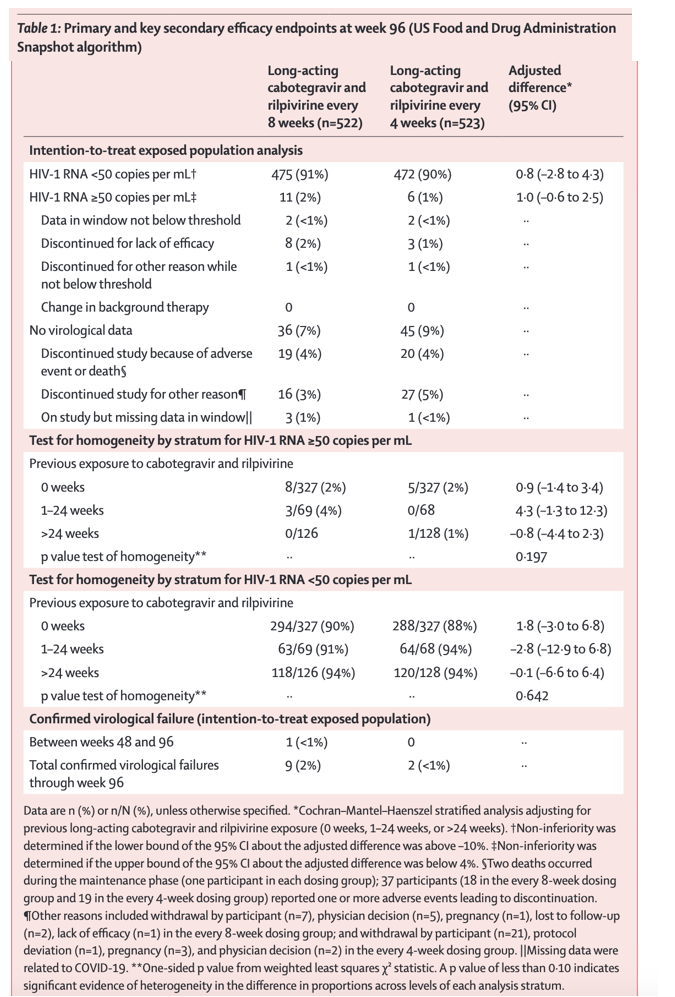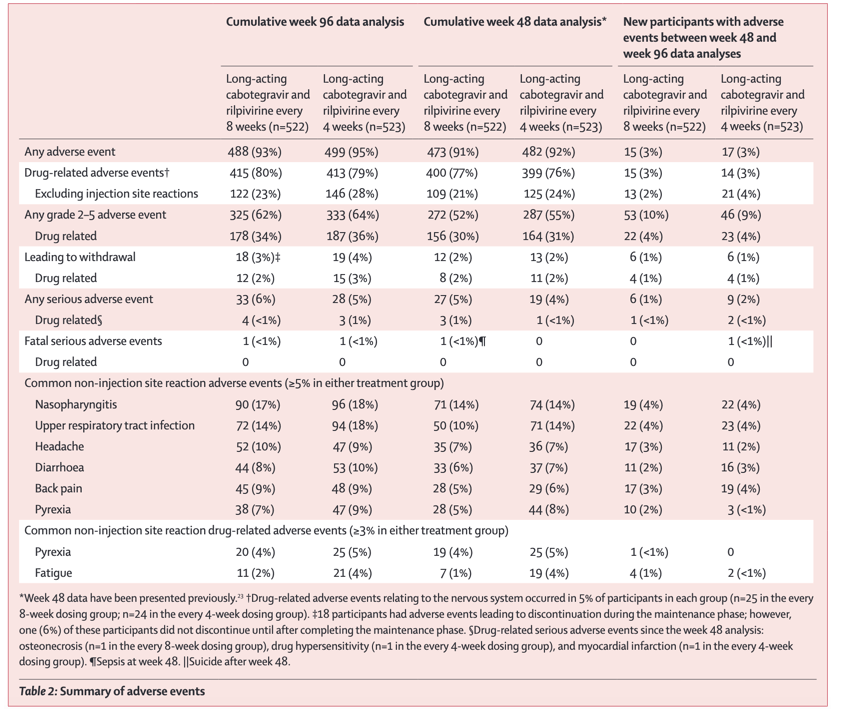| |
Long-acting cabotegravir and rilpivirine dosed every 2 months in adults with HIV-1 infection (ATLAS-2M), 96-week results: a randomised, multicentre, open-label, phase 3b, non-inferiority study
|
| |
| |
Download the PDF here
Lancet HIV Oct 2021
High treatment compliance was observed across both groups, with no injections missed without oral bridging, potentially reflecting the flexibility of the 15-day dosing window that was permitted with this treatment. No cases of confirmed virological failure were observed during the period of oral therapy or following resumption of long-acting cabotegravir and rilpivirine dosing. This finding is promising for real-world applications, as the study visit schedules and corresponding clinical assessments were designed to simulate the anticipated real-world implementation of each dosing regimen.
Overall, the rate of confirmed virological failure was generally low across both groups, with only one participant meeting the confirmed virological failure criterion since the week 48 analysis in the every 8-week dosing group. Most participants with confirmed virological failure in the every 8-week dosing group had pre-existing resistance-associated mutations to rilpivirine at baseline, compared with none in the every 4-week dosing group. The small number of participants with confirmed virological failure in this study limited our ability to form robust conclusions and identify predictors of virological failure. A multivariable analysis, using pooled data from the phase 3 and phase 3b ATLAS, FLAIR, and ATLAS-2M studies, suggests that an increased risk of confirmed virological failure when two or more of the following baseline factors are present: pro-viral rilpivirine resistance-associated mutations, HIV-1 subtype A6/A1, or a BMI of 30 kg/m2 or more. Factors such as cabotegravir week 8 trough concentration, baseline integrase Lys74Ile (excluding mixtures with Lys74Met) polymorphism, baseline integrase strand transfer inhibitor mutations, baseline non-nucleoside reverse transcriptase inhibitor resistance-associated mutations (excluding rilpivirine resistance-associated mutations), being assigned female at birth, and dosing regimen were also analysed and were found to not significantly increase the likelihood of virological failure. Furthermore, the presence of any one factor alone was not associated with confirmed virological failure. This finding is important, as six participants who had confirmed virological failure in ATLAS-2M had two or more of the baseline factors associated with increased risk of confirmed virological failure.27
The median weight change found in this study is consistent with a median weight gain of 2⋅0 kg for long-acting cabotegravir and rilpivirine every 4 weeks observed in the previous phase 3 FLAIR study over 96 weeks,22 and was similar to those reported in previous clinical trials for other ARTs.28
The cabotegravir and rilpivirine plasma concentration data were consistent with those observed in the phase 2b LATTE-2 study.29
High suppression was maintained for both regimens with no inverse relationship between cabotegravir or rilpivirine pharmacokinetics and virological non-response. Multiple factors, including plasma concentrations and viral phenotype, might be associated with the occurrence of virological failure.27
Summary
Background
Long-acting cabotegravir and rilpivirine administered monthly or every 2 months might address the challenges associated with daily oral antiretroviral therapy. The ATLAS-2M week 48 results showed non-inferiority of long-acting cabotegravir and rilpivirine administered every 8 weeks compared with that of every 4 weeks. In this study, we report the efficacy, safety, and tolerability results from the week 96 analysis.
Methods
ATLAS-2M is a randomised, multicentre, open-label, phase 3b, non-inferiority trial conducted in 13 countries, evaluating the safety and efficacy of maintenance treatment with intramuscular injections of long-acting cabotegravir and rilpivirine, administered every 8 weeks versus every 4 weeks, to people living with HIV-1. Virologically suppressed adults with HIV-1, either already receiving intramuscular long-acting cabotegravir and rilpivirine every 4 weeks (ie, ATLAS study rollover participants) or oral standard of care, were randomly assigned (1:1), in an unblinded fashion, to receive either intramuscular long-acting cabotegravir (600 mg) and rilpivirine (900 mg) every 8 weeks (ie, the every 8-week dosing group) or intramuscular long-acting cabotegravir (400 mg) and rilpivirine (600 mg) every 4 weeks (ie, the every 4-week dosing group). Randomisation was generated using the GlaxoSmithKline-validated randomisation software RANDALL NG (version 1.3.3). The primary endpoint at week 48 was the proportion of participants with plasma HIV-1 RNA measurements of 50 copies per mL or more (ie, the US Food and Drug Administration [FDA] Snapshot algorithm), which has been published previously. Here, we present the week 96 results: the proportion of participants with plasma HIV-1 RNA measurements of less than 50 copies per mL (FDA Snapshot algorithm), with a non-inferiority margin of -10%; the proportion of participants with plasma HIV-1 RNA measurements of 50 copies per mL or more (FDA Snapshot algorithm), with a non-inferiority margin of 4%; the proportion of participants with protocol-defined confirmed virological failure (ie, two consecutive plasma HIV-1 RNA measurements ≥200 copies per mL); safety; pharmacokinetics; and tolerability. This study is registered with ClinicalTrials.gov, number NCT03299049, and is currently ongoing.
Findings
Between Oct 27, 2017, and May 31, 2018, a total of 1149 participants were screened; of whom, 1049 (91%) were randomly assigned and 1045 (91%) initiated treatment (522 in the every 8-week dosing group and 523 in the every 4-week dosing group). The median age was 42 years (IQR 34-50). 280 (27%) of 1045 participants were assigned female at birth and 764 (73%) were white.
At week 96 (FDA Snapshot algorithm), 11 (2%) of 522 participants in the every 8-week dosing group and six (1%) of 523 in the every 4-week dosing group had an HIV-1 RNA measurement of 50 copies per mL or more, with an adjusted treatment difference of 1⋅0 (95% CI -0⋅6 to 2⋅5), meeting the prespecified non-inferiority threshold of 4%; 475 (91%) of 522 participants in the every 8-week dosing group and 472 (90%) of 523 in the every 4-week dosing group maintained an HIV-1 RNA measurement of less than 50 copies per mL, with an adjusted treatment difference of 0⋅8 (95% CI -2⋅8 to 4⋅3), which met the prespecified non-inferiority threshold of -10%.
One participant in the every 8-week dosing group met the confirmed virological failure criterion since the week 48 analysis at week 88, resulting in a total of nine participants in the every 8-week dosing group and two in the every 4-week dosing group having confirmed virological failure.
No new safety signals were identified, and no treatment-related deaths occurred. Injection site reactions were the most common adverse event, occurring in 412 (79%) of 522 participants in the every 8-week dosing group and 400 (76%) of 523 in the every 4-week dosing group. Most injection site reactions were grade 1 or 2 (7453 [99%] of 7557 in both groups), with a median duration of 3 days (IQR 2-5).
Interpretation
Long-acting cabotegravir and rilpivirine dosed every 8 weeks had non-inferior efficacy compared with that of every 4 weeks through the 96-week analysis, with both regimens maintaining high levels of virological suppression. These results show the durable safety, efficacy, and acceptability of dosing long-acting cabotegravir and rilpivirine monthly and every 2 months as maintenance therapy for people living with HIV-1.
Funding
ViiV Healthcare and Janssen Research & Development.



|
|
| |
| |
|
|
|